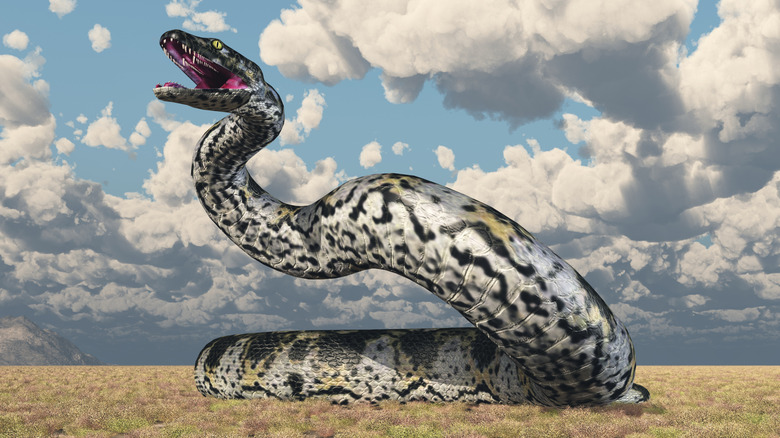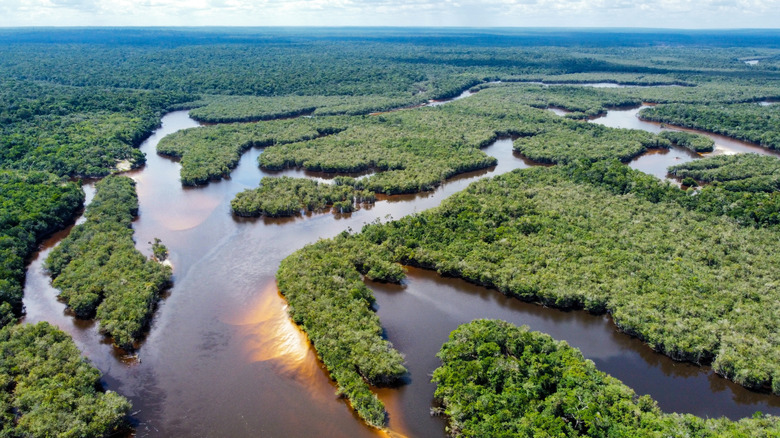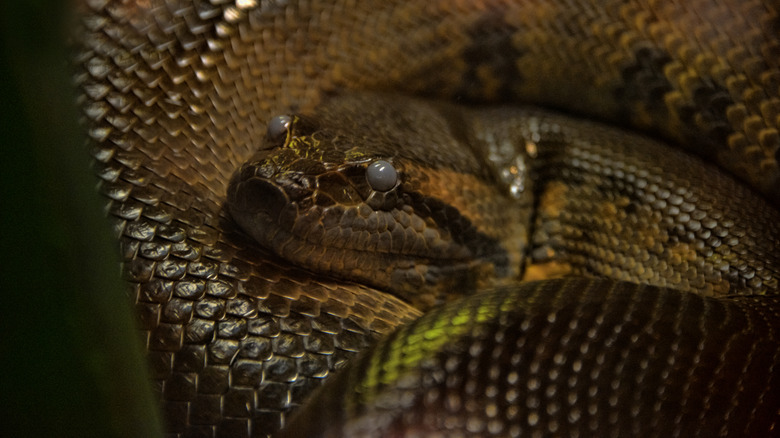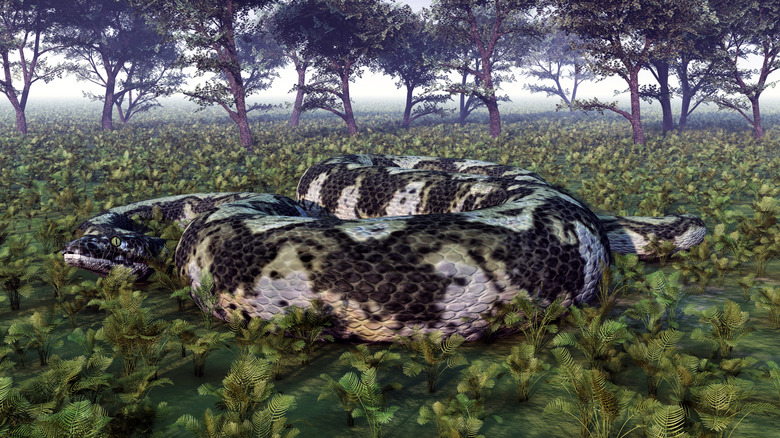What If Titanoboa Never Went Extinct?
Titanoboa was the largest snake ever known to have slithered the Earth. It stunned the scientific world in 2009, when a team of researchers announced the discovery of a massive snake fossil found in the Cerrejón coal mine in Colombia, dubbed Titanoboa cerrejonensis, or simply, Titanoboa. Since then, fossils from 30 different individuals have been uncovered, and they reveal that members of the species likely averaged around 42 feet in length, and weighed roughly 2,500 pounds. That's heavier than a full-grown male bison.
Titanoboa was a member of the taxonomic order Squamata, which is the same order that boa constrictors, anacondas, and pythons belong to. Titanoboa far outmatched its modern relatives though, being over 10 feet longer and four times heavier than the biggest anacondas. It would have been too heavy to live in trees, and it is believed that Titanoboa actually spent most of its time in the water.
These massive snakes ruled the Paleocene rainforest between 58 million and 60 million years ago. There is a great deal of debate over precisely when and why Titanoboa went extinct, but the prevailing theory is that cooling global temperatures at the end of the Paleocene made it impossible for this cold-blooded giant to sustain itself. But, what if Titanoboa had found a way through this challenge, and was still dwelling in the Amazon rainforest to this day?
The Amazonian food chain would be very different
If Titanoboa was still winding its way through the rainforest today, it would absolutely dominate the food chain. This was one of the largest predators to have existed since the mass extinction of the dinosaurs, a force unlike any of the present-day animals competing for food in the Amazon. Scientists believe that Titanoboa primarily ate fish from the rivers it swam through, which would make it the only member of its taxonomic family to have a predominantly pescatarian diet. However, given Titanoboa's immense size, it is thought that the massive snake could eat almost anything in its vicinity, including crocodilians.
Currently, the largest predator in the Amazon River basin is the black caiman, a relative of alligators that feasts on everything from piranhas to dogs and livestock. The largest black caimans can reach 20 feet in length and weigh over 700 pounds. That's plenty enough to make them an apex predator today, but they wouldn't stand a chance against Titanoboa, which could be more than twice as large. Juvenile caimans are already prey to large anacondas, so a supersized snake could certainly turn to grown caimans for a meal. Other apex predators of the Amazon, like arapaima and even anacondas themselves, would be knocked down a peg on the food chain if Titanoboa was still in the mix.
Titanoboa could threaten humans and livestock
If Titanoboa still existed, humans would be the one animal that could threaten it, but only by virtue of our weaponry. The massive serpent would still pose a threat to us, as well as the animals we have domesticated, something we can safely assume given our history with a different large snake species: the green anaconda
Green anacondas aren't nearly as formidable as Titanoboas were, but they are the closest thing to the extinct snakes that we have on Earth today. Like Titanoboa, the green anaconda spends much of its time swimming through the waters of the Amazon rainforest. It also has a penchant for tackling large prey both in the water and on land, including deer and capybara. They even eat caimans on occasion. Although very rare, there have been instances of anacondas attacking humans and trying to drag them into the water. It's important to note that there are no records of an anaconda actually eating someone, but a Titanoboa's version of such an attack could potentially prove deadly.
Climate might make Titanoboa even bigger
As horrifyingly large as the ancient Titanoboa was, if it had survived to this day, it might start growing even bigger. To explain why, we need to cover how Titanoboa got so big in the first place. Reptiles, being cold-blooded, need to rely on their environment for heat. Bigger bodies require more heat, which is why most large reptiles are found around the tropics. Titanoboa lived during a time of elevated global temperatures, during which the Amazon rainforest was significantly hotter than it is today.
Not only was Titanoboa bigger than any of today's snakes, but the reptiles it ate, like crocodiles and turtles, were also much larger than their modern counterparts. Due to the wide-sweeping consequences of global warming on the environment, temperatures in the Amazon could once again reach the levels of Titanoboa's time before the century is out. Since humanity has thus far failed to curb anthropogenic climate change, there is no sign that global temperatures will stop climbing, potentially even beyond their Paleocene levels. In light of this, some scientists have predicted that modern reptiles will evolve to have larger bodies in the future. Perhaps the descendants of today's anacondas will bring a new Titanoboa-like presence in the Amazon.



